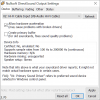ctcwired
Member
Latency spikes should not happen, unless the switch's chipset is total garbage or there is routing in the middle (and again, with a poorly underscaled router).
This isn't quite the case. Many non-realtime OSes (Windows, macOS) tend to buffer and vomit full size frames onto the network, in bursts. If there's no QoS, this can lead to latency spikes (on the order of 500 - 1000μs) on a shared switch link further down the chain. Even if the connection isn't quite maxed, just the process of scaling TCP window sizes around involves hitting many types of choke points on a network. This is never an issue for PC users of course but a Dante system might care if you're targeting very low latencies. So even if you have internet with only say 20mbps upload, and your LAN is gigabit... the process of initially starting an upload (lets say speedtest.net starts an upload test) the computer will often spike the PHY rate in several spots, before the speed settles and the packets coming into the switch become more evenly spaced out.
DSCP flags resolve this problem almost entirely, and is one of the reasons they recommend a switch with such feature.
In comparison, AVB switches handle this on an even lower layer, by reserving "Time Domains" with a scheduler that can guarantee packets flow in an exact expected timeframe, achieving microsecond consistency, making it useful for SDI video systems that need genlock as well.
That all said, this is getting very nitty-gritty, and in practice on a reasonable switch, following basic guides with default settings you're unlikely to run into an issue.





